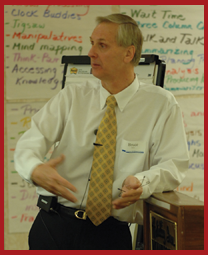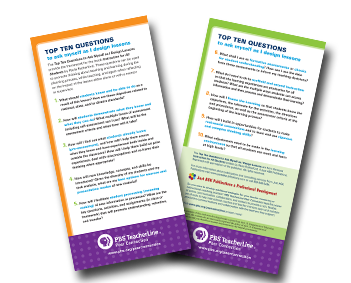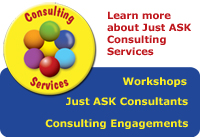
Volume VIII Issue II
Share this newsletter on
Success Factors in Diverse Schools

Bruce facilitating a Leading the Learning® workshop
The term diverse is often used to provide a picture of a school’s demographics by ethnicity, socioeconomic status, English proficiency, education designation (e.g., special education services), and past achievement levels. In a more expanded view of diversity, we know that most of our students could be described as diverse since they have different learning styles, learn at different rates, have different interests, and different levels of readiness as they approach new learning. Most of our schools are becoming more and more diverse over time. Some school demographic patterns offer greater challenges in the quest to meet the learning needs of all students. It is complicated, demanding, often stressful work that requires tenacity, patience, and strength of will among the adults in these schools.
Schools that have successfully tackled the demands of highly diverse environments view their jobs not with a sense of desperation, but as obstacles which can be addressed and overcome. Through hard work, determination, open minds, energized leaders, and forward-looking teachers, they have achieved success. We all know that not all ideas work in all environments. Nevertheless, there are certain beliefs and practices that have been shown to consistently impact student achievement in a positive way.
In the subsequent paragraphs, you will find thought-provoking ideas that may help to increase student learning in diverse environments. Some of the ideas are part of education’s current lexicon and have received extensive attention in the literature. They, nonetheless, bear repeating since they fit into the category of “tried and true.” Other ideas may be less publicized but may initiate conversations that have the potential to positively impact student learning.
All members of the school community adhere to and act on the same set of beliefs.
Studies have concluded that highly successful teachers enter their classrooms daily with the mindset that their students can achieve and get “smart” through effective effort. They are unwavering in their belief and it is represented in the high expectations and “can do” attitude they convey to their students. They bring a sense of excitement and energy to the learning environment. If students are expected to learn, then the teacher’s expectations must be clear, consistent and repeated. Students must not only believe that their teacher expects them to learn, but they must also believe in their own ability to learn. Moreover, as is evidenced by frequent and public discussions of actions based on these beliefs, every teacher in the school is on board with this common set of principles.
All students are provided with instruction that is engaging, purposeful, challenging, and that is guaranteed from classroom to classroom across the school.
In flourishing school environments, there is one major priority that is considered a non-negotiable: Without exception, all teachers are expected to immerse themselves in their craft; they are steadfast in their belief that they can help students learn, and they plan lessons which captivate and maintain student attention. In such schools, there is job-embedded staff development to support teachers in reaching this goal. There is a high visibility of administrators and fellow educators in and out of classrooms; teaching and learning is considered a public experience and that the best way to get better is to see one another in action. If and when teachers falter, rather than judgment, there is instead quick and unrelenting support for those teachers to make sure that all students are the recipients of a quality learning experience. Not only are these goals aggressively pursued, there is greater effort to make sure that every teacher performs at the highest level possible.
All teachers know their students well.
It has been repeatedly shown that when teachers get to know their students and make it a practice to intentionally build relationships with each individual, the students come to trust their teachers, open their minds to new learning, buy into the curriculum, willingly ask for teacher assistance, and embrace the idea that the teacher and the student are on the same team. It is especially important for teachers to reach out to individuals who may be inadvertently overlooked because they are quiet, reticent to call attention to themselves, face frustration when they encounter new learning, and may not have had a positive relationship with teachers in the past.
Teachers identify individual learning deficits quickly and intervene purposefully.
Successful teachers do not let gaps in students’ ability to make progress linger indefinitely. They are so tuned in to how their students learn that they address learning deficiencies with deliberate speed. Through the use of frequent checks for understanding, the collection and examination of written summarizing exercises, and the consistent examination of individual student assessment data, teachers are able to provide timely and frequent feedback to address student shortcomings. When learning deficiencies are overlooked or ignored, students bring their anxieties into the classroom which results in resistant behavior and eventually tension between teachers and students. As educator and journalist Bryan Goodwin has written, “If left unchecked too long, learning difficulties may snowball to a point that even the most intensive (and costly) of interventions will produce, at best, mixed results.” When teachers act quickly to fill in the gaps in student learning, they often find that students learn at a quicker rate thus eliminating the need for later remediation.
Leaders meet the professional development needs of individual teachers.
Wise leaders are tuned in to the needs of their staff members. In some instances, full staff participation in professional development activities is appropriate and necessary. However, in other circumstances, only individuals or small groups of teachers may need training or focused attention. We have come to know that the “one size fits all” approach to teaching our students is passé; therefore, the same practice should be applied to our adult learners. Training for individuals or selected groups of teachers may be provided by peers, central office personnel or school leaders. Teachers can also add to their skills through peer observations coupled with feedback and reflection, or from collaborative discussions of successful practices with fellow teachers. With time being such a precious commodity for teachers, especially in schools where there is a wide variance in student diversity, it is important for leaders to be respectful of how teacher time is used.
The school declares war on absenteeism.
It is a “no brainer” that if students are not in school, they cannot learn. In successful environments, chronic absenteeism is viewed as a major deterrent to students’ ability to meet learning goals, and thus, having the students in school on a consistent basis becomes a high priority. Research has found that this focus on consistent attendance must start in the early grades. In these schools, the educators put together a plan of action that is sequential, specific, and carefully crafted. When a pattern of student absences is detected early, the plan is put into effect. In short, the school believes in being proactive instead of reactive. Included in many school plans are consistent written communication and/or phone calls to families early on in order to fend off any attendance problem that may emerge later on. Additionally, parent conferences and home visits are made in order to emphasize the debilitating impact on student motivation and learning when students fall further and further behind because of absences. In order to enlist the support of families, there must be a sense of trust; the school outreach program should not be judgmental since success may eventually come when all participants cooperate fully in the venture.
New teachers are hired carefully and steadfastly maintained when they are successful.
Unequivocally, the most important ingredient in meeting the needs of all students is the effectiveness of the classroom teacher. Therefore, it is essential that when teachers are hired to work in highly diverse schools, they must be carefully chosen to make sure they understand the demands they will face in the learning environment. As leaders or teacher panels interview and make hiring decisions, they must ensure that potential candidates have a realistic view of the school where they will work. New staff members must understand the teaching and learning challenges they will face in highly diverse cultures. Honesty must prevail because when hiring mismatches are made, everyone suffers. It is also important for the school to be forthcoming in conveying the amount and depth of support the newly hired individual will receive. Smart schools do not “throw new hires to the wolves” but instead provide competent mentors, administrative support, encouraging but realistic feedback, and a safety net should they encounter difficulties. As school personnel seek the best candidates possible, they must look for a belief system that matches the school’s mission. Whereas a good candidate states her belief that all students can learn, a potentially great candidate adds specifics about what he plans to do to ensure student success.
Teachers avoid traditional practices that have little impact on student learning.
When student achievement continues to be on the rise, there is often a professional assumption that is part of the school belief system: Teachers must be sure that their methodology clearly matches the needs of the school populations. They realize that practices that are commonplace will no longer meet the learning needs of their students. Harvard professor Richard Elmore has determined that when teachers experiment with new ways to doing things and “push the envelope of their knowledge and competencies,” new beliefs have a solid chance of taking hold and thus, have a greater impact on overall student learning. Additionally, when teachers challenge their students to do work that is considered “too hard,” students often rise to the occasion because they are not viewed as mediocre learners or less than competent. Teachers must ask themselves important questions such as “Why am I planning this learning experience?” and “Is this the best use of instructional time?” Practices that may be a mismatch include worksheets, copying notes, completing packets, extensive coloring, or following a textbook sequence that does not necessarily match teaching standards. Time is too precious to waste on instructional approaches that simply do not promote learning.
Strike a balance between rules and flexibility.
Zero tolerance policies have been in effect in schools for several decades. Following this practice, there are automatic punishments for rule infractions. Many of the punishments translate into long suspensions or expulsions. A recent Washington Post editorial stated, “Research has shown that out-of-school suspensions hurt academic progress; are a major factor in students’ dropping out; and because they don’t teach new behaviors, fail to improve school climates.” Some school districts, such as Baltimore City Public Schools, are taking a closer look at the zero tolerance practices and modifying their policies when infractions do not fall into the “dangerous” categories. University of Virginia professor Daniel Duke has concluded that firmness coupled with a caring attitude by teachers and school authorities can work better. In order to promote learning, some teachers are revising their classroom conventions to include multiple opportunities to reach mastery level learning (80% or above), flexible but intractable due dates, and concessions for students who are far behind their peers. As educational blogger Nancy Flannagan has written, “Paying attention to individual kids is a better strategy than making an inflexible rule.”
Connect learning to family and community.
All schools, regardless of demographics of their student body, should have a healthy relationship with their families and communities. As diversity becomes more pronounced, the importance of involving and reaching out to the family and community members becomes even more important. Schools that are finding the greatest success in meeting the needs of their diverse learners are proactive in educating their parents and community about the life of the school. They not only reach out to their families, they invite community members, including business and religious leaders, into their schools to see firsthand their programs and instructional initiatives. They are learning that often those outside the school have a misconception about what happens in their local school buildings. Once inside, they see hard-working adults and children in healthy, thriving environments. Thus, their support increases. Other successful schools have found that supports provided by the school and services provided by the local government are often duplicated or completely non-existent due to a lack of communication. They are now communicating regularly, pooling resources, and devising plans that are truly helping individual students and their families as well as sub-groups within the school.
Hopefully the ten practices presented here will provide food for thought as you continue in your quest to improve the achievement of your students. You may want to work collaboratively to rank order the ideas in terms of potential impact, assess which are in place and functioning smoothly or are currently not well established norms, or consider what other variables should be considered.
Permission is granted for reprinting and distribution of this newsletter for non-commercial use only. Please include the following citation on all copies:
Oliver, Bruce. “Success Factor’s in Diverse Schools” Just for the ASKing! February 2011. Reproduced with permission of Just ASK Publications & Professional Development (Just ASK). © 2011 Just ASK. All rights reserved. Available at www.justaskpublications.com.
Free Top Ten Tips to Ask Myself as I Design Lessons
“These questions can be used to promote thinking about teaching and learning during the planning process, while teaching, and again when reflecting on the impact of the lesson either alone or with a mentor or supervisor.”




